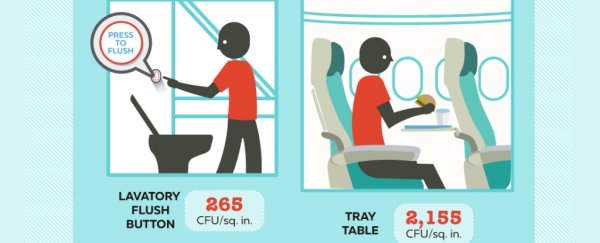It's no surprise to anyone that aeroplanes and airports are hotspots of disease. The constant stream of people coming in and out from all parts of the world, with all kinds of illnesses, means that a whole lot of viruses and bacteria are spread during air travel.
But what are the grossest places in the cabin? Travel site Travelmath asked a microbiologist to visit five airports and four different aeroplanes, and swab commonly touched areas to find out which had the highest concentration of bacteria. And let's just say the bathroom is the least of your worries.
The results showed that the innocent-looking tray table was the most bacteria-infested surface tested, beating out the toilet flush button and seatbelt buckle for the top spot.
The microbiologist worked this out by swabbing different areas, and then growing the results on an agar plate so the bacteria that had been lurking on the test sites could form colonies. You can then count the number of colonies that grow from each swab, and use this to measure how many colony-forming units (CFU) there were in each square centimetre - or in the case of this US-made infographic, each square inch.
As you can see below, a tray table on an aeroplane has around 2,155 CFU/square inch (332 CFU/square centimetre), while the toilet flush button only has 265 CFU/square inch (41/square centimetre).
The items in airports didn't fare much better in this study, with drinking fountain buttons having a crazy 1,240 CFU/square inch (191 CFU/square centimetre). To put that into perspective, your home toilet seat has around 172 CFU/square inch (26.5 CFU/square centimetre).
The good news is that there were no traces of faecal coliforms, which are bacteria such as E. coli that can make you pretty sick, found in any of the tests. And even better news: just because something is covered in bacteria, doesn't necessarily make it bad for you.
In fact, the antibacterial products people often take on long-haul flights in an attempt to ward off bugs don't work any better than regular soap - and there's evidence they could actually be doing you harm, in addition to contributing to the rise of antibiotic resistance.
So if looking at this infographic makes you want to reach for some kind of hand sanitiser, stick with an alcohol-based gel, which actually has some scientific backing that it keeps things clean.
See the full results below (high res here) and remember, wash your hands frequently, avoid licking your tray table, and don't panic - bacteria isn't all that bad:

